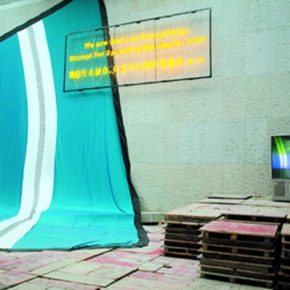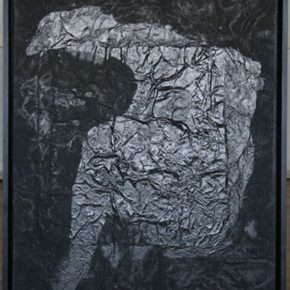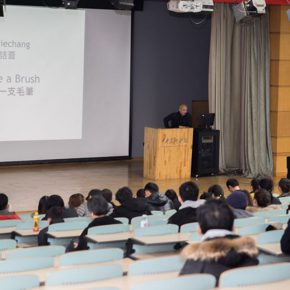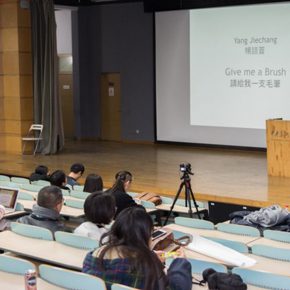
At 6:30 pm on the evening of December 22, 2016, hosted by the School of Experimental Art, CAFA, the lecture entitled “Give Me a Brush” by Yang Jiechang, was held in the Auditorium of the Northern Zone in CAFA. The lecture was presided over by Prof. Qiu Zhijie, Dean of the School of Experimental Art, CAFA. The artist Yang Jiechang started from his research and an interpretation of his works, and then talked about the “bachelor” in his creative ideas, as well as his unique meaning and value in contemporary art.
“Give Me a Brush, I Will Create Wealth Again”In China, there are a variety of narratives about Chinese contemporary art. The unique nature of Yang Jiechang is that he is a contemporary artist influenced by the traditions of Chinese painting and calligraphy. Through the brush, Yang constantly interrogates the heart, while overlapping and blending the traditional aesthetics, spirit of “bachelor” with contemporary art. Then, it formed an artistic appeal, and Qiu Zhijie calls it “the very thing, instead of anything else, that must be done”.
For Chinese intellectuals, the connotation of “bachelor” has constantly changed since the new cultural movement. In the view of Yang Jiechang, when Chinese “bachelors” encounter a disaster, they understand the laws of nature, and understanding the impermanence of the world is also normal. Yang recalled that,“In the 2008 financial tsunami, the editor of the British magazine Philips asked me what the impact of the financial tsunami was on me. I blurted out a sentence, ‘Give me a brush, and I will create my wealth again’”. As a “bachelor”, Yang Jiechang admitted that he had never given up the brush to participate in contemporary art when he lived in Europe for three decades. In the face of crisis, the “bachelor” usually stabilizes their own heart at once, so as to achieve the “benign” development of things.
Origin and Original Intention: Moving the Self and the OthersYang Jiechang places the memorials to his teacher and early works in his studio, which can be regarded as thanksgiving and return of the gift. He talked about the impact of Taoist Huang Tao as well as the denied graduation work “Slaughter” which was created in 1982. As a graduate of the first session of the Department of Chinese Painting after the end of the Cultural Revolution, the “Slaughter” went against the rules of “Goodness and the Beautiful” of that time, so it was not adopted by the school. Looking back at the old work, Yang Jiechang said frankly that: “I still remember how it touched me and moved the surrounding people during those years.
In 1987, Jean-Hubert Martin, Director of the Centre Pompidou in Paris, Francecame to China to find Chinese artists for his planned exhibition “Les Magiciens de la Terre”. Recommended by Hou Hanru, Yang Jiechang met the curator and he was finally invited to participate in the exhibition, but the works original selected were detained at Customs. Without any choice, Yang took his brush to rethink the creation, “I didn’t know what I could draw, but I still kept painting, using the technology of multiple dyeing of the Chinese Hue Art to continue to dye.” Eventually, the exhibition work “Thousand Layers of Ink” kept the distance of decades of centimeters on the wall, the black cubes present the artist’s knowledge of the traditional and contemporary, time and space.
“Disaster” in the Sense of BeautyThen he settled in a foreign country for decades, Yang began trying to constantly create new works, and drawing nutrients from many cultures including the painting of the Song Dynasty, Taoism and Japanese Bushido theory. Yang Jiechang said that, in art he always used “disaster” to form a sense of beauty. Chinese ink is already full of beauty, how to find the “third party?” To find the third one between beauty and ugliness is the place for him to think. In addition, Yang Jiechang said pure “Chinese contemporary art” was absent in the Western context, and “there is only negotiation, rather than exchange.” Especially in Chinese art, Western people and local Chinese people still have prejudiced learning.
Subsequently, Yang Jiechang demonstrated many of his works, such as: “Testament”: the combination of pottery and Japanese Zen theory, allowed himto escape from the political black and white, through the art return to create the truth. “The Forty-Four-Year-Old Self-Portrait” (Paris, 1996): he warned himself at that time, that although the situation was bad, he had a healthy body, so that, one should be strong, or he would become overwhelmed; “Oh, My God”: during the period of 911 incident, he was inspired by the young man, who escaped from the ruins and shouted “Oh, my god”. Yang Jiechang believed that 911 was the time to change the times and he used the Cantonese pronunciation to write “Oh, Diu” and thus it formed the correspondence and negotiation between Cantonese and English. “Difficult”: the use of Chinese calligraphy to write in English, which came from thinking after the finish of “Thousand Layers of Ink”, the artists need to know that although it is “difficult”, they must change; “Artists Have to Work Hard”: the caution to himself and hiding the reality of art.
“As a Person, One Should Have Feedback and be Alert in Society.”As a Cantonese person, the territorial has also been a concern of the artist and it derives from a wider range of social thinking through a geographical discussion. Yang Jiechang presented the installation “Pearl River” at the Guangzhou Triennial: “We Know All Things, But We Can’t Speak Mandarin Well.”, concerned about the preservation of regional culture, when Mandarin is implemented as the common language, the connotation and value of the regional language of Cantonese language should also be squarely faced, in addition, in the work “Individual Community”, he had thrown the paintings, which were not contemporary art, into the trash. Yang asked: Was it too early to summarize Chinese contemporary art? He said: “As a person, one should have feedback and be alert in society.” History has been judged and screened, and the “authenticity” of history is still worth discussing, while people need to remain vigilant and reflective.
Subsequently, Yang Jiechang continued to introduce the works “The Mustard Seed Garden”, “Talk in November”, “Still Chinese Bird-and-Flower Painting”, and the “Buddhist Bone Relic”. In the “Still Chinese Bird-and-Flower Painting” Yang copied the works by Hitler, he found Hitler lacked humor and imagination, which was a disaster. He said that although we could not save Hitler, we could save ourselves and our descendants. In contrast, the Emperor Huizong of the Song Dynasty rated the entire system of the Chinese civilization of art, he was full of imagination. Yang believed that we could try to use the aesthetics to observe the world, instead of just judging history by text. In addition, in the work “Buddhist Bone Relic”, it reveals the artist’s attitude to life and death, while warning his numbness. At the same time, the work also contains the Taoist recognition of failure and disaster, as well as the mind and pursuit in considering all things as common things.
Text by Yu Ya, translated by Chen Peihua and edited by Sue/CAFA ART INFO
Photo by Hu Sichen/CAFA ART INFO, Part of the photo of the works is from the internet.







































